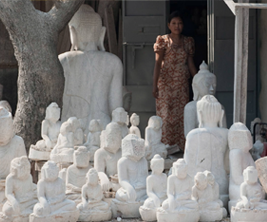About 21 miles north of Mandalay, the second largest city of Burma, lays Sagyin Mountain. ‘Sagyin’ in Burmese means ‘marble’. The mountain range consists of 7 hills – four to the north and three to the south. The Sagyin Hill range is an offshoot of the mountains of Mogok, the world’s best ruby land. But the hills are more well-known for their pure white and blueish grey marble. Sagyin marble is highly rated for its hardness, beauty and texture. The Kyauk Dawgyi Pagoda near Manda- lay Hill in Madalay, contains an 11-meter enormous image of the Buddha carved from a single rock of marble from Sagyin. This sitting Buddha image is the largest in the nation that weighs about 600 tons. Nearby, the Kuthodaw Pagoda contains 729 white marble tablets that preserve ancient Bud- dhist text and scripture.
The Burmese craft of sculpting pristine white Buddha statues from marble is centu- ries-old. This craft gained popularity during the 17th century, prior to which the Buddha statues were cast in bronze and sandstone. Buddhism in Myanmar is predominantly of the Theravada tradition, practised by 89% of the country’s population. It is the most religious Buddhist country which fueled the growth of the trade of statues of Buddha. The trappings of religious practice are in evidence everywhere in the public and pri- vate spaces throughout the country. Tens of thousands of temples across the country,
as well as monasteries, public buildings and homes, invariably contain a Buddha image. Even when you are not visiting one of the many beautifully built, lavishly decorated, and lovingly maintained temples you will notice Buddhist iconography and religious items all around. A short walk through the streets of Mandalay illustrates the religious
richness of Burmese traditions.
In Mandalay near the famous Mahamuni Pa- goda there is a thriving industry of craftsmen creating marble Buddha statues for the tour- ist industry and others. U Pho Ni says, “My family has been carving statues for the last four decades and it has been passed on the craft to the next generation”. Chit Ko, his son,
now runs the workshop, which specializes in small Buddha statues that are sold to Manda- lay souvenir shops. His 19-year-old son, John Ko Ko, will also inherit the craft soon.
Like U Pho Ni’s, there are around 5,000 families all over Myanmar who are involved in the business of carving Buddha statues thereby earning their livelihoods. Large marble blocks are carefully carved into Bud- dha images on site and sent to Buddhist monasteries all over Burma The men ham- mer and chisel the stone, while the women polish the finished statues. Men usually earn
“My family has been carving statues for the last four decades and it has been passed on the craft to the next generation”










